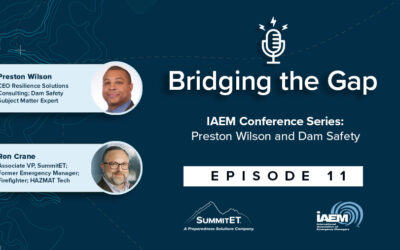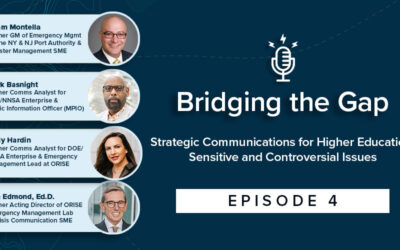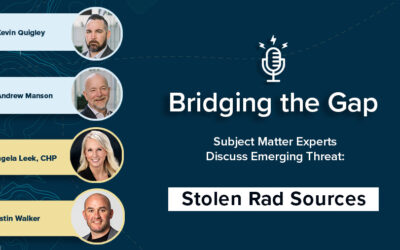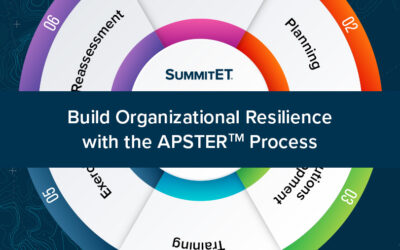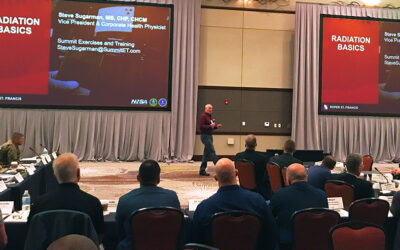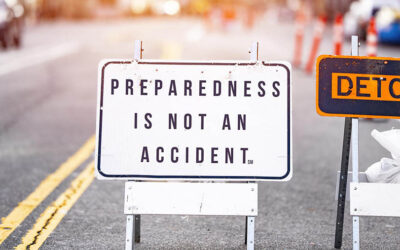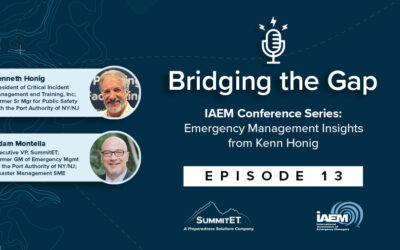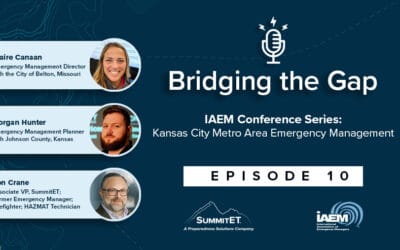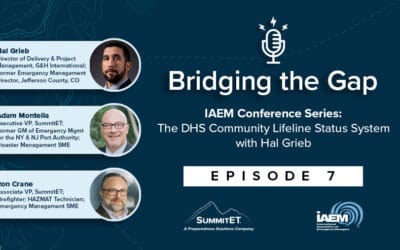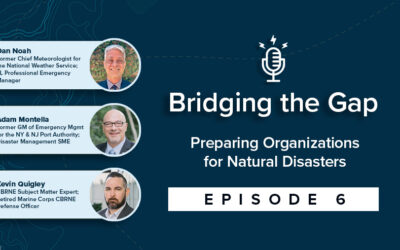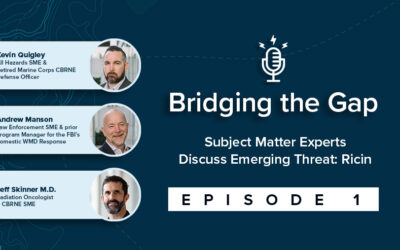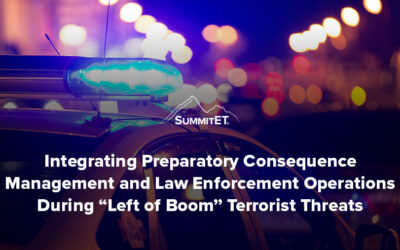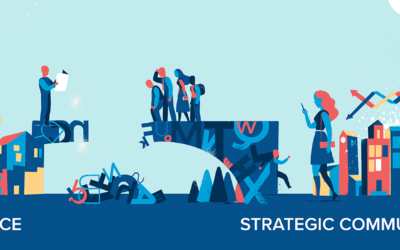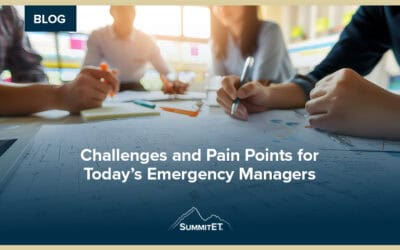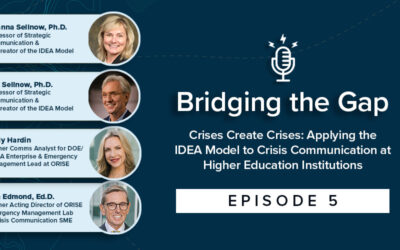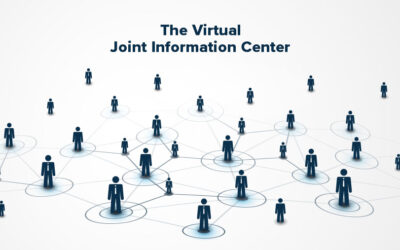Preparedness Blog
Stay Connected
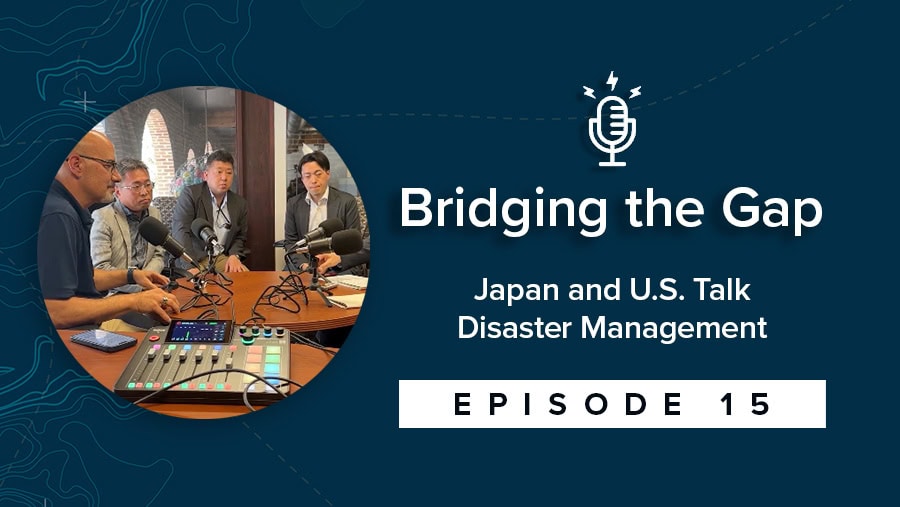
Bridging the Gap Episode 15: Japan and U.S. Experts Talk Disaster Management
In this episode of Bridging the Gap, SummitET had the honor of hosting a distinguished delegation of disaster management experts from Japan. This visit, ahead of the National Hurricane Conference, provided a unique opportunity to exchange ideas and share experiences in disaster management and preparedness.
Bridging the Gap IAEM Series – Episode 14: The Student Perspective on Emergency Management
In this special IAEM Conference Series episode of Bridging the Gap, SummitET podcast host and former emergency manager Ron Crane meets with Massachusetts Maritime Academy students about their experiences studying and interning in Emergency Management and their perceptions regarding challenges in the field.
Bridging the Gap IAEM Series – Episode 11: Preston Wilson and Dam Safety
In this special IAEM Conference Series episode of Bridging the Gap, host Ron Crane with SummitET is joined by Preston Wilson, CEO of Resilience Solutions Consulting. Prior to this role, Preston was the training manager for FEMA’s National Dam Safety Program, where he was responsible for developing and delivering training on emergency management and dam safety nationwide.
Bridging the Gap IAEM Series – Episode 8: Jeremy Urekew and Garner Environmental
In this IAEM Conference Series episode of SummitET’s podcast Bridging the Gap, Jeremy Urekew with Garner Environmental and Ron Crane of SummitET discuss ideas for improving challenges in the Emergency Management field. Jeremy has a background in emergency management, fire service, hazmat response, and counterterrorism work. With 25 years of experience in the public sector, he moved to the private sector by joining Garner Environmental Services, Inc., a disaster and emergency response company headquartered in Houston, TX.
Emergency Management Practices: Insights from Recent Colorado Wildfires
Recent wildfires in Colorado brought to the forefront the critical importance of effective emergency management practices. Explore the role of strategic communications and technological tools in wildfire preparedness, response, recovery, and mitigation.
Bridging the Gap Episode 4: Strategic Communications for Higher Education: Sensitive and Controversial Issues
In this podcast episode, SummitET’s team of Strategic Communications experts discuss crisis communications fundamentals that higher education institutions can incorporate when addressing controversial and sensitive issues with their stakeholders.
Bridging the Gap Episode 2: Stolen Radiation Sources
SummitET Subject Matter Experts (SMEs) discuss the emerging threat of stolen radiation sources.
Build Organizational Resiliency Within Strategic Communications
The APSTER Process is a SummitET proprietary process for building organizational resiliency and preparedness within strategic communications.
Quick Thoughts on Messaging and Communicating for Health Physicists
Original Post HPS News Steve Sugarman*, MS, CHP, SummitET Vice President and Corporate Health Physicist, SummitET.com Acknowledgements: Mark Basnight, SummitET Vice President of Communications and Marketing; Holly Hardin, SummitET Strategic Communications Program...
Seven Benefits of Native Social Media Drills and Exercises
We have identified seven benefits of using native social media accounts to conduct crisis communications drills and exercises.
Preparedness is Not an Accident®
Identifying what to prepare your business for can be a challenge. Find out where to start.
Maintaining Trust and Preparing for Change During a Crisis
Open, accurate, and consistent communication is one of the most important parts of an effective crisis response. Learn to facilitate trusting relationships with stakeholders.
In a Crisis? Got a Plan?
Planning for the inevitable, a crisis or emergency, is a practice every organization should employ. Planning, strategizing, training, and exercising are essential functions for any organization to successfully weather a crisis or emergency.
Identifying and Addressing Misinformation and Combating Disinformation on Social Media: The Viral Spread of Coronavirus
How to identify and address the spread of COVID misinformation on social media.
Bridging the Gap IAEM Series – Episode 13: Emergency Management Insights from Kenn Honig
In this special IAEM Conference Series episode of Bridging the Gap, SummitET host Adam Montella is joined by Kenn Honig, a seasoned emergency management consultant with a long career in law enforcement and emergency management at the Port Authority of New York and New Jersey. Join this insightful discussion as they navigate the evolution of emergency management practices, the technological advancements over the decades, and the undeniable importance of personal contacts in the field.
Bridging the Gap IAEM Series – Episode 10: Kansas City Metro Area Emergency Management
In this IAEM Conference Series podcast episode of Bridging the Gap, SummitET host Ron Crane sits down with Claire Canaan and Morgan Hunter, emergency managers from the Kansas City metropolitan area. They discuss challenges in the EM field including staffing shortages and communication barriers, and the importance of embracing change and innovation.
Bridging the Gap IAEM Series – Episode 7: The DHS Community Lifeline Status System with Hal Grieb
In this special IAEM Conference Series episode of Bridging the Gap, SummitET experts discuss the Community Lifeline Status System Project with Hal Grieb of G&H International Services. This software reporting tool is developed for the DHS to operationalize FEMA’s Community Lifelines construct and provides a data-driven framework to help emergency managers assess and report on critical services during disasters.
Bridging the Gap Episode 6: Preparing Organizations for Natural Disasters
In this episode of the “Bridging the Gap” podcast, disaster preparedness experts discuss business continuity planning for natural disasters, emphasizing the importance of including all stakeholders, from employees to the CEO, as well as local and federal government.
Bridging the Gap Episode 3, Part 1: Improving Exercise Design and Evaluation; the XF Score
In this podcast episode, SummitET preparedness experts and former DHS Acting Secretary and FEMA Administrator discuss the XF Score™️, a rubric for analyzing the effectiveness of tabletop exercises and trainings for crises.
Bridging the Gap Episode 1: Bioterrorism and Ricin
SummitET Subject Matter Experts (SMEs) discuss the possible implications of a ricin bomb as a Weapon of Mass Destruction (WMD).
Integrating Preparatory Consequence Management and Law Enforcement Operations During “Left of Boom” Terrorist Threats
A new planning approach enabling all levels of government to integrate their operations to maximize their ability to stop the terrorist.
Benefits of Enhanced Crisis Communication Skills
Enhanced crisis communication skills help organizations meet the growing demands for information related to an emergency event. Learn all the benefits.
Combating Cyber Threats in Telework Environments
With many industries quickly shifting to telework, cyber-threat actors are taking advantage of new vulnerabilities to cyber systems. Learn to reduce these threats.
Our Global Situation – How Business Can Prepare Going Forward
Six-steps to help address the challenges you will likely face as a business owner and leader in the new normal.
Hospital Preparedness; The Four S’s of Surge Capacity
Surge capacity is unique for each hospital. However, it does not mean the larger hospital has an infinite surge capacity. Learn the 4 S’s of surge capacity.
What the Fusion of Social Science and Strategic Communications means for Private Industry
Providing practitioners with scientifically-proven methodologies and strategies to enhance internal and external communications.
Communicating Technical Information to a Non-technical Audience
Here are some thoughts for those tasked with communicating technical information to a non-technical audience.
Bridging the Gap IAEM Series – Episode 12: D.C. Metro Area Emergency Management
In this special IAEM Conference Series episode of Bridging the Gap, Shannon McCrone, TT&E Program Manager with the U.S. House Sergeant at Arms and Ron Benedict, Readiness, Response and Resiliency Program Manager with DC Department of Health share their experiences, challenges, and ideas for improvement in emergency management in the DC metro area.
Bridging the Gap IAEM Series – Episode 9: Kevin Kupietz with Elizabeth City State University
In this IAEM Conference Series podcast episode of Bridging the Gap, SummitET host Ron Crane discusses current challenges and opportunities in Emergency Management education with Elizabeth City State University Professor Kevin Kupietz, PhD.
Challenges and Pain Points for Today’s Emergency Managers
Today’s emergency managers are tasked with navigating an ever-increasing array of threats, from natural disasters to technological hazards, while coordinating response efforts across multiple agencies and stakeholders. Here, we delve into some of the most pressing pain points that these professionals face in their mission to safeguard communities.
Bridging the Gap Episode 5: Crises Create Crises: Applying the IDEA Model to Crisis Communication at Higher Education Institutions
In this podcast episode, SummitET Strategic Communications experts sit down with the creators of the IDEA Model for Effective Risk and Crisis Communication and discuss how communicators and decision-makers at higher education institutions can apply the the model when addressing sensitive and controversial issues on their campuses.
Active Shooter Incidents Over Time
“Active shooters” were not always considered cause for alarm in the United States. This post examines the trend of active shooter incidents over time and offers preparedness solutions to mitigate the threat.
What Your Radiological Communications May Be Missing
When communicating effects of a radiological incident, it’s important to have this one thing to effectively communicate to the public.
Nuclear Power Plants are going Virtual for Communications Trainings and Exercises
Nuclear power plants and Offsite Response Organizations virtual strategic communication to meet training and exercise requirements.
What is the Virtual Joint Information System (JIS) / Joint Information Center (JIC)
What is the virtual joint information system (JIS) and Join information Center (JIC) and the benefits of communicating digitally?
Communication Complexities: Real Talk
We are living in unprecedented times and facing new challenges requiring different approaches and well-practiced communication skill sets. This blog addresses how to approach individual and organizational communication strength training.
Flattening the Social Media Monitoring Curve
Consider these 7 steps in monitoring social media in order to decipher your information requirements and facilitate the decision-making process.
Communication Through Message Mapping
Messages play an important role in determining the success of communication efforts before, during, and after a crisis. Learn to message map to communicate the major issues facing your organizations during a crisis.
Self-Preservation for the Communication Professional – Insight from the Frontlines
Communication professionals are working around the clock to gather, verify, and distribute critical information to their internal and external stakeholders. Learn how to recognize the signs of psychological fatigue and reduce stress.
Natural Disasters Take a Toll on the US Economy: and it’s Only Getting Worse
Looking at the global picture of natural disasters and what businesses can do to prepare.
Preparedness is not an accident®.
Sign up for our newsletter to receive the latest preparedness news, free preparedness resources, and invitations to preparedness workshops.


